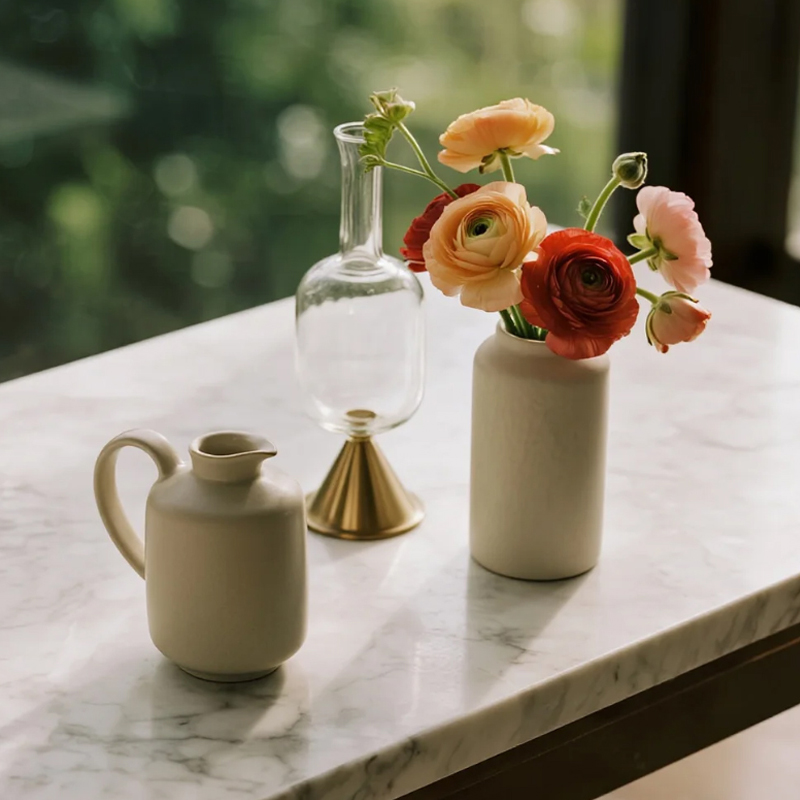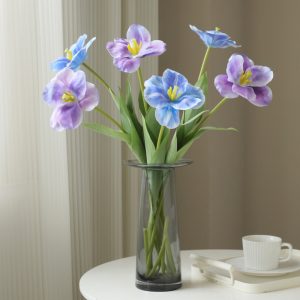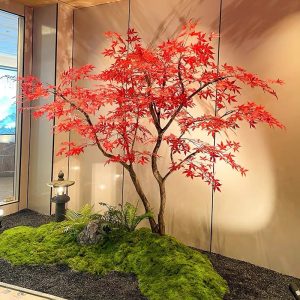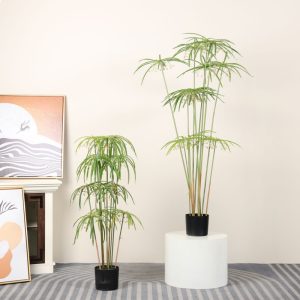Preface
In hotel lobbies, shopping malls, and exhibition spaces, artificial plants have become a quiet revolution — green yet maintenance-free, decorative yet durable. For professional buyers, selecting high-quality, easy-to-maintain, and visually realistic artificial plants is not merely a design choice but a business strategy that balances cost, efficiency, and brand perception. Over the past 48 hours, several noteworthy developments have emerged: from the launch of weather-resistant outdoor artificial plants to new market reports warning of oversaturation in the artificial tree sector, alongside a growing spotlight on sustainability and simplified upkeep. Drawing on more than a decade of experience observing this industry, I’ll examine these signals through the lenses of market trends, technology, environmental policy, and supply chain shifts — to reveal where the synthetic greenery business is heading.
Ⅰ. Recent Industry Highlights
- The Plants Project (Melbourne, Australia) unveiled its Premium Outdoor Artificial Plant Collection on 17 October 2025, targeting balconies, rooftops, and commercial spaces. The line highlights UV and weather resistance, durability against wind and rain, and zero need for watering or chemical maintenance. It positions artificial greenery firmly within outdoor commercial design.
(Source: PR Newswire via Plataforma Media, Oct 17 2025 — plataformamedia.com) - Sinleen Artificial Plants, a major manufacturer of artificial trees and synthetic greenery, released its white paper Artificial Tree Market – Trends Analysis 2025 on 13 October 2025. It outlines a typical market curve of “rapid rise → saturation → quality differentiation”, stressing that for B2B procurement, quality assurance, logistics costs, and inventory management are now critical focus areas.
(Source: Sinleen Blog, Oct 14 2025 — sinleenplants.com) - A Technavio report from January 2025 forecasts that the U.S. market for artificial plants and flowers will expand by approximately USD 380 million between 2025 and 2029, at a CAGR of 3.4%. Commercial demand — particularly from hotels and office environments — is driving this growth, while fluctuations in raw material prices (such as plastics and polyester) remain the main constraint.
(Source: Technavio via PR Newswire, Jan 9 2025 — prnewswire.com)
Ⅱ. In-depth Analysis
Market and Trends
These stories reveal a clear transformation: the artificial plant sector is moving beyond indoor décor towards outdoor, landscape, and large-scale applications. The Plants Project’s latest launch — promising “no water, no chemicals, weatherproof design” — reflects a growing demand among commercial clients such as hotels, malls, rooftop gardens, and outdoor dining venues for simplified maintenance.
For buyers, the concept of “maintenance of artificial plants” extends far beyond routine dusting. It’s about cutting long-term operational costs — no watering, no fertilising, no pest control, no seasonal dieback.
Sinleen’s white paper meanwhile flags the risks of oversaturation and quality divergence, warning bulk buyers to avoid chasing “viral trends”. Rapidly launched products often come with rising return rates, inconsistent quality, and logistics expenses that can balloon by 200–300% for large artificial trees. (sinleenplants.com) For professional clients — including exhibition decorators, hotel groups, and commercial developers — it’s a call for prudence: prioritise stable, proven models over short-lived “social media hits”.
The U.S. market data adds another dimension: although demand continues to rise, the pace is steady, not explosive, and raw material volatility is the underlying concern. (prnewswire.com)
In essence:
- Maintenance of artificial plants has become a purchasing keyword synonymous with operational savings.
- Technological upgrades in artificial greenery are advancing from surface aesthetics to durability, structural precision, and hyper-realistic detailing.
- Eco-friendly materials are shifting from a niche feature to a competitive advantage within procurement discussions.
Technology and Material Innovation
The Plants Project case exemplifies the industry’s R&D direction — using advanced UV-resistant polymers and realistic surface textures modelled on live species (plataformamedia.com). For outdoor and commercial environments, this blend of resilience and realism defines the next generation of artificial greenery.
Sinleen’s report, on the other hand, reveals an increasingly industrialised quality control process — up to 12 QC steps, weight standardisation, compression testing, and protective packaging to reduce transport damage (sinleenplants.com).
While polyester and plastic remain dominant, the premium segment is leaning towards recyclable and low-emission alternatives. According to sector analyses, artificial plants made from durable, UV-stable polymers, recyclable compounds, and low-VOC dyes are gaining favour among hospitality and retail chains (artificialplantssupplier.com).
For professional buyers, this technological upgrade signals a shift: beyond appearances, they should now ask for UV resistance certifications (e.g. UV 5000 h tests), structural lifespan data, and modular repair options (e.g. replaceable leaf clusters).

Sustainability and Policy Directions
Although sustainability remains a weak point in the artificial plant market, its momentum is undeniable. As EdenVert notes, while some critics dismiss synthetic plants as environmentally unfriendly, long-life artificial greenery can actually reduce water use, soil depletion, and pesticide reliance over its lifecycle (eden-vert.com).
From a material standpoint, traditional plastics and polyester face mounting scrutiny through environmental taxes and chemical regulations. Consequently, buyers are beginning to examine whether the eco-friendly materials in synthetic plants meet recyclability and safety standards, and whether they comply with green certification frameworks such as LEED or BREEAM. (globenewswire.com)
Should artificial greenery be formally recognised as a category of sustainable décor material, demand from hotels and commercial properties could surge. Buyers would be wise to request “Material Safety Reports”, “Recyclability Certificates”, and “Lifespan Test Results” from their suppliers to reinforce procurement credibility.
Supply Chain and International Trade Shifts
Sinleen’s data highlights a significant challenge — logistics costs for large artificial trees have risen by 200–300%, and inventory overhang is common. (sinleenplants.com) For international bulk buyers and exhibition contractors, this means structural rethinking: adopting KD (knock-down) designs, compact packaging, and modular assembly to reduce freight volume.
Other key patterns include:
- High mould investment (USD 15,000–30,000 per new model) with 3–6 month ROI cycles.
- Short product lifespans for trend-driven lines, leading to depreciation risks.
- Lead times averaging 30–45 days — projects should be scheduled at least half a year in advance.
- Shipping volatility — freight, tariffs, and container loading efficiency now directly influence pricing.
Collectively, these forces are pushing buyers to evaluate total ownership cost (TOC) rather than unit price — considering not only purchase and shipping but also installation, cleaning, refurbishment, and eventual disposal. The true maintenance of artificial plants thus spans the entire lifecycle, from selection to replacement.
Ⅲ. Industry Insights and Future Directions
From my observations, the following recommendations are especially relevant to bulk buyers:
- Prioritise low-maintenance designs. For hotel lobbies, atriums, or rooftop gardens, choose products with high UV resistance, water-free installation, and modular replacement capability. Maintenance of artificial plants is often misunderstood as just dusting — yet faded foliage or deformed stems can result in far higher long-term costs.
- Partner with technologically advanced suppliers. Verify whether your supplier conducts UV tests, structural durability assessments, and packaging stress trials. For exhibition contractors, products that can be assembled, disassembled, and re-used quickly represent tangible savings.
- Integrate sustainability into procurement. As commercial real-estate and hospitality sectors embed green operations into their branding, eco-friendly materials in synthetic greenery will become mandatory rather than optional. Recyclable plastics, low-VOC pigments, and life-cycle transparency can all enhance a brand’s credibility.
- Balance trend and timelessness. Sinleen’s data shows classic models like the Olive Tree outperform short-term viral hits in reorder and return rates (sinleenplants.com). Stable designs offer predictable supply and inventory control — critical for professional buyers managing long-term contracts.
- Calculate total ownership cost. Consider every stage — logistics, installation, cleaning, repair, replacement, and disposal. This holistic view clarifies true cost efficiency far better than unit pricing alone.
- Explore outdoor applications. The Plants Project’s launch underscores a fast-emerging niche: outdoor commercial greenery for rooftops, terraces, resorts, and open-air venues. The opportunity is promising, provided the products meet safety, stability, and aesthetic standards.
Future Outlook
- Weather-resistant artificial greenery will dominate procurement lists as outdoor commercial design expands.
- Eco-friendly materials will transition from bonus feature to baseline requirement.
- Modular, replaceable-part systems will gain traction among hotels and malls seeking longevity.
- Data-driven product selection will increase — with buyers relying on Google Trends, social metrics, and supplier intelligence to avoid overstock.
- Freight cost control and packaging optimisation will remain decisive for global trade competitiveness.
Ⅳ. Conclusion and Reflection
To understand artificial plants today is to see them not as mere imitations of nature but as engineered systems that merge aesthetics with operational logic. For professional buyers — hotels, malls, or exhibition contractors — the winning formula blends realism, low maintenance, durability, and brand alignment.
Recent product launches, supply chain analyses, and market forecasts collectively highlight a steady yet complex landscape. Maintenance efficiency, technological sophistication, and sustainability are no longer separate topics — they form the three axes of future decision-making.
根据我的观点,From my perspective, the next 3–5 years will see artificial greenery evolve from decorative accessories into strategic assets: tools that reduce operational load while enriching brand experience. Choosing the right product today, therefore, is not merely a purchase — it’s a long-term investment in resilience, reputation, and responsibility.













